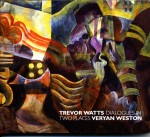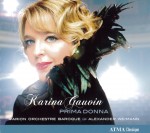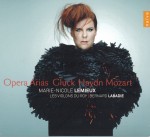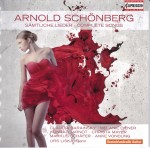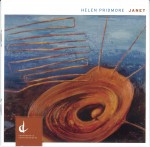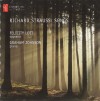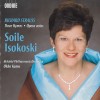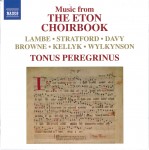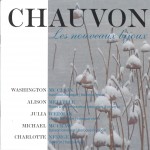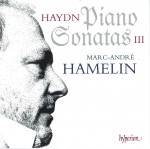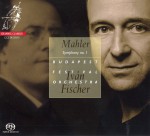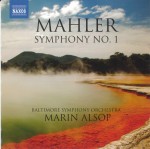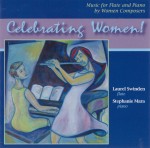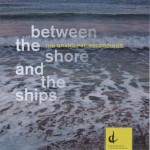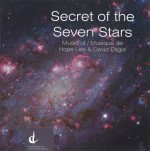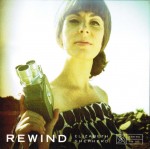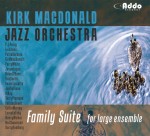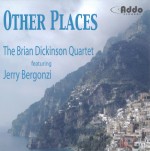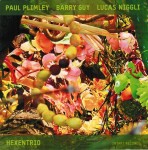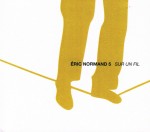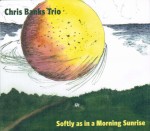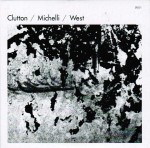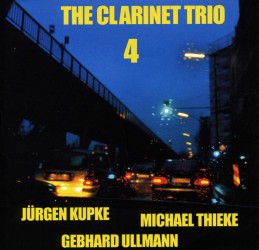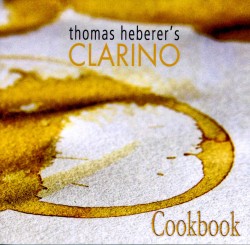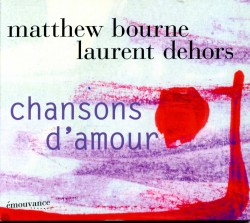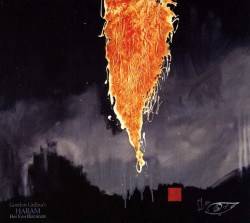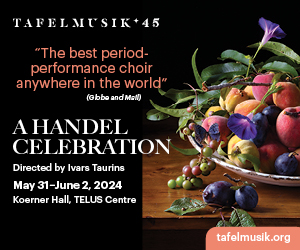Old Wine, New Bottles | Fine Old Recordings Re-Released - December 2012
The difficulty for this reviewer with any of the many different omnibus collections that have appeared in cubes of various sizes over the last while is where to start, what to sample first? Sometimes it is easier ... in any Beethoven Symphonies collection I start with the Fourth, but let me share a new quandary:
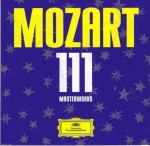 Deutsche Grammophon has released a further inexpensive collection to commemorate their 111th anniversary, MOZART 111 containing 111 compositions on 55 CDs (DG 4750059). Representing his entire oeuvre are 111 complete works played by various artists from every performance practice. I acknowledge that I know most of the works reasonably well and some quite well. Also many of the various recordings are in the back of my mind somewhere. So what would you listen to first when every disc is equally enticing? Here is the menu: Symphonies 25, 26, 29, 38, 39 (Pinnock/ECO), 28, 33 (Levine/PO), 32, 35, 36 (Karajan/BPO), 40, 41 (Minkowski/Musiciens du Louvre); Piano concertos 6, 17, 21 (Anda/Salzburg Mozarteums), 27, 10 for two pianos (Emil & Elena Gilels/Böhm/VPO), 19, 23 (Pollini/Böhm/VPO), 20, 24 (Bilson/Gardiner), 14, 26 (Pires/Abbado/VPO); Various concertos, violin 3, 4, 5 (Perlman/Levine/VPO), Sinfonia Concertante K364, Concertone K190 (Perlman/Zukermann/Mehta/Israel PO), clarinet K622, flute K313, flute and harp K299, Andante for flute K315, oboe K314, bassoon K191, horn 1, 2, 3, 4 (Orpheus Chamber); Serenades: K361; wind serenades K375, K388 (Orpheus Chamber),”Posthorn” K320, “Eine Kleine Nachtmusik” K525 (Levine/VPO), Serenata Notturna K239, Divertimento K334 (Karajan/BPO); String quartets, the six Haydn Quartets (Hagen); Miscellany, Divertimento K334, Masonic Funeral Music K477 (Böhm/VPO). And that’s only the first 23 discs out of 55, and the best is yet to come! The church music, the Requiem (Abbado/VPO), more chamber music, many recitals and complete operas: Idomeneo, Die Entführung aus dem Serail, Le Nozze di Figaro, Don Giovanni, Cosi fan tutte and Die Zauberflöte. For many decades the DG sound has been ideal for Mozart and with these acknowledged masters of the repertoire, it really wasn’t that hard to get into the collection; getting out was hard.
Deutsche Grammophon has released a further inexpensive collection to commemorate their 111th anniversary, MOZART 111 containing 111 compositions on 55 CDs (DG 4750059). Representing his entire oeuvre are 111 complete works played by various artists from every performance practice. I acknowledge that I know most of the works reasonably well and some quite well. Also many of the various recordings are in the back of my mind somewhere. So what would you listen to first when every disc is equally enticing? Here is the menu: Symphonies 25, 26, 29, 38, 39 (Pinnock/ECO), 28, 33 (Levine/PO), 32, 35, 36 (Karajan/BPO), 40, 41 (Minkowski/Musiciens du Louvre); Piano concertos 6, 17, 21 (Anda/Salzburg Mozarteums), 27, 10 for two pianos (Emil & Elena Gilels/Böhm/VPO), 19, 23 (Pollini/Böhm/VPO), 20, 24 (Bilson/Gardiner), 14, 26 (Pires/Abbado/VPO); Various concertos, violin 3, 4, 5 (Perlman/Levine/VPO), Sinfonia Concertante K364, Concertone K190 (Perlman/Zukermann/Mehta/Israel PO), clarinet K622, flute K313, flute and harp K299, Andante for flute K315, oboe K314, bassoon K191, horn 1, 2, 3, 4 (Orpheus Chamber); Serenades: K361; wind serenades K375, K388 (Orpheus Chamber),”Posthorn” K320, “Eine Kleine Nachtmusik” K525 (Levine/VPO), Serenata Notturna K239, Divertimento K334 (Karajan/BPO); String quartets, the six Haydn Quartets (Hagen); Miscellany, Divertimento K334, Masonic Funeral Music K477 (Böhm/VPO). And that’s only the first 23 discs out of 55, and the best is yet to come! The church music, the Requiem (Abbado/VPO), more chamber music, many recitals and complete operas: Idomeneo, Die Entführung aus dem Serail, Le Nozze di Figaro, Don Giovanni, Cosi fan tutte and Die Zauberflöte. For many decades the DG sound has been ideal for Mozart and with these acknowledged masters of the repertoire, it really wasn’t that hard to get into the collection; getting out was hard.
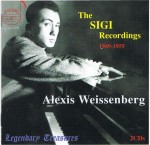 “Nobody that I have ever heard played the piano any better than Alexis Weissenberg.” This pronouncement was made by Glenn Gould on August 24, 1977 on a CBC radio program devoted to Weissenberg. The evidence to support this statement can be certainly heard on a new collection devoted to the artistry of the young Alexis Weissenberg, recorded between 1949 and 1955 (The Sigi Recordings DOREMI DHR-7987/8, 2 CDs). Until his mid-20s he went by the name Sigi Weissenberg and his first three LPs are credited to that name. Every bar on these recordings made by Columbia and the French label Lumen confirms an innate pianistic and artistic talent of immense stature. One could now easily argue that he never played better than he is heard here. He recorded much of this repertoire again for EMI but not nearly at the same level of bravura, freshness and excitement. I went directly to a particularly favourite work, the Liszt Sonata and was literally astounded by the towering performance and the true-to-life sound. Incomparable on any level! Similarly, the other works portray the same pianistic achievement, from Bach-Liszt, Haydn, Soler, Czerny, Prokofiev, Scriabin and more Liszt. An unexpected and important release. You must hear that Liszt Sonata!
“Nobody that I have ever heard played the piano any better than Alexis Weissenberg.” This pronouncement was made by Glenn Gould on August 24, 1977 on a CBC radio program devoted to Weissenberg. The evidence to support this statement can be certainly heard on a new collection devoted to the artistry of the young Alexis Weissenberg, recorded between 1949 and 1955 (The Sigi Recordings DOREMI DHR-7987/8, 2 CDs). Until his mid-20s he went by the name Sigi Weissenberg and his first three LPs are credited to that name. Every bar on these recordings made by Columbia and the French label Lumen confirms an innate pianistic and artistic talent of immense stature. One could now easily argue that he never played better than he is heard here. He recorded much of this repertoire again for EMI but not nearly at the same level of bravura, freshness and excitement. I went directly to a particularly favourite work, the Liszt Sonata and was literally astounded by the towering performance and the true-to-life sound. Incomparable on any level! Similarly, the other works portray the same pianistic achievement, from Bach-Liszt, Haydn, Soler, Czerny, Prokofiev, Scriabin and more Liszt. An unexpected and important release. You must hear that Liszt Sonata!
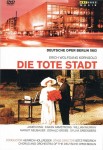 Before he came to Hollywood in 1934, Erich Wolfgang Korngold (1897–1957) was lauded as a child prodigy and then as a prodigious composer. One of his more renowned operas was Die Tote Stadt, first performed in 1924 in Berlin with Lotte Lehmann and Richard Tauber in the leads. Korngold’s movie scores are today accepted as classics, Anthony Adverse, King’s Row, The Sea Hawk, Robin Hood and many more, but his operas are rarely mounted. Die Tote Stadt is full of great romantic tunes and falls comfortably on the ear. However, the plot is quite macabre and more than somewhat difficult to grasp. Some of it is real and the rest is in the skewed and haunted mind of Paul, the central figure who, it seems, killed his wife earlier. This 1983 production by the Deutsche Oper Berlin (Arthaus Musik 101656) staged by Gotz Friedrich stars his wife, Karan Armstrong and James King as Paul. The set and costumes are perfect for the 1920s and, at last, the plot is clear ... I think. The conductor is Heinrich Hollreiser and there is a bonus track with Friedrich introducing the opera and clarifying the plot.
Before he came to Hollywood in 1934, Erich Wolfgang Korngold (1897–1957) was lauded as a child prodigy and then as a prodigious composer. One of his more renowned operas was Die Tote Stadt, first performed in 1924 in Berlin with Lotte Lehmann and Richard Tauber in the leads. Korngold’s movie scores are today accepted as classics, Anthony Adverse, King’s Row, The Sea Hawk, Robin Hood and many more, but his operas are rarely mounted. Die Tote Stadt is full of great romantic tunes and falls comfortably on the ear. However, the plot is quite macabre and more than somewhat difficult to grasp. Some of it is real and the rest is in the skewed and haunted mind of Paul, the central figure who, it seems, killed his wife earlier. This 1983 production by the Deutsche Oper Berlin (Arthaus Musik 101656) staged by Gotz Friedrich stars his wife, Karan Armstrong and James King as Paul. The set and costumes are perfect for the 1920s and, at last, the plot is clear ... I think. The conductor is Heinrich Hollreiser and there is a bonus track with Friedrich introducing the opera and clarifying the plot.
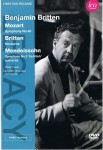 Readers with an awareness of historic performers may be wish to spend an hour or so with Benjamin Britten conducting the English Chamber Orchestra on a new DVD from ICA (ICAD 5083). These are live performances from Fairfield Halls in Croydon on December 20, 1964 as telecast in black and white by the BBC. The concert begins with a nifty performance of the Mozart Symphony No.40, quite straightforward but beautifully played with sustained lines. To end the concert Peter Pears joins Britten for a magnificent performance of Britten’s Nocturne Op.60 for tenor, seven obbligato instruments and strings. I have been listening to this work for decades but the intensity of this performance touched me, revealing its true quality. Britten admirers owe it to themselves to hear and see this outstanding performance. There are two bonus tracks in full colour from a concert at The Maltings on June 5, 1970, in which they play the Adagio and Scherzo from Mendelssohn’s Scottish Symphony.
Readers with an awareness of historic performers may be wish to spend an hour or so with Benjamin Britten conducting the English Chamber Orchestra on a new DVD from ICA (ICAD 5083). These are live performances from Fairfield Halls in Croydon on December 20, 1964 as telecast in black and white by the BBC. The concert begins with a nifty performance of the Mozart Symphony No.40, quite straightforward but beautifully played with sustained lines. To end the concert Peter Pears joins Britten for a magnificent performance of Britten’s Nocturne Op.60 for tenor, seven obbligato instruments and strings. I have been listening to this work for decades but the intensity of this performance touched me, revealing its true quality. Britten admirers owe it to themselves to hear and see this outstanding performance. There are two bonus tracks in full colour from a concert at The Maltings on June 5, 1970, in which they play the Adagio and Scherzo from Mendelssohn’s Scottish Symphony.
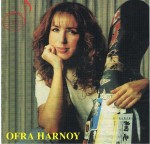 One of the most pleasant CDs to come my way recently is Ofra Harnoy and Friends (DOREMI DHR 6609). The selections were recorded during the 1980s and 1990s but most are new to her discography. Repertoire ranges from Vivaldi to Gershwin via Mozart, Beethoven, Rimsky-Korsakov, de Falla and several lesser known names. She impresses by her versatility in adapting to the various styles, projecting the joy of music making in whatever the repertoire. It is also evident that her enthusiasm is shared by her colleagues. Harnoy was popular with young audiences and with her special appeal had drawn them into classical music. She was, as they say, a natural! Before her retirement from the concert stage to raise a family, the cellist had close to 40 discs listed in the Schwann catalogue. Additionally hers was a familiar name on Billboard’s International Best Sellers charts. Included on this refreshing compilation are performances with Igor Oistrakh in the Vivaldi Double Concerto RV546 and Maureen Forrester in Massenet’s delightful Élégie. An enjoyable 80 minutes.
One of the most pleasant CDs to come my way recently is Ofra Harnoy and Friends (DOREMI DHR 6609). The selections were recorded during the 1980s and 1990s but most are new to her discography. Repertoire ranges from Vivaldi to Gershwin via Mozart, Beethoven, Rimsky-Korsakov, de Falla and several lesser known names. She impresses by her versatility in adapting to the various styles, projecting the joy of music making in whatever the repertoire. It is also evident that her enthusiasm is shared by her colleagues. Harnoy was popular with young audiences and with her special appeal had drawn them into classical music. She was, as they say, a natural! Before her retirement from the concert stage to raise a family, the cellist had close to 40 discs listed in the Schwann catalogue. Additionally hers was a familiar name on Billboard’s International Best Sellers charts. Included on this refreshing compilation are performances with Igor Oistrakh in the Vivaldi Double Concerto RV546 and Maureen Forrester in Massenet’s delightful Élégie. An enjoyable 80 minutes.


